Introduction
Small and medium enterprises (SMEs) are a major component of the private sector. SMEs have now become an important engine of economic growth and seed beds for entrepreneurship. Their business activities can be generalized as home-based, farm-based and street-based with a number of full time workers less than five or their sales turnover is less than USD80,000 (Saleh and Ndubisi, 2006). Common products and services include food and beverages, arts, cultural and heritage items, education and consultation and real estate.
However, many SMEs operate in the informal sector and are technologically backward due to the lack of funding, weak management practices and unfriendly environmental production processes (APO, 2007).
In Malaysia, microenterprises dominate the businesses establishment in the country which is comprised of 78.6% of the total number of businesses (National SME Development Council, 2010). The Malaysian government has established the Small and Medium Industries Development Corporation (SMIDEC) in 1996 to promote the development of the indigenous enterprises through skills development programs and other financial assistance. Studies on SMEs in Malaysia cited that the low level of technology is one of the factors that hamper the competitiveness of SMEs (Za’afaran, 2007).
To reduce the low adoption rate, SMIDEC has promoted the use of e-commerce by introducing electronic malls and portals for SMEs to conduct trade electronically (Za’afaran, 2007). However, the government effort to promote the use of IT in SMEs does not yield the expected results.
While IT adoption has become a synonym to studies in IT, most of the work focuses on the adoption barriers (Husnayati and Rafidah, 2005; Hashim, 2007; Alam and Mohamad Noor, 2009). The ability to use the computers and technology knowhow has been found to be common challenges to IT adoption among microenterprises. However, very little research effort is seen in promoting the adoption of IT amongst non-adopters microenterprises.
Therefore, the research attempts to design and propose an appropriate IT adoption technique for this business group. Based on the work of Wolcott et al (2007), a possible adoption method known as IT therapy was identified as an intervention program to induce and promote IT usage. The main aim of the study is to formalize the IT therapy method as by developing its descriptive model on a group of batik microenterprises in Malaysia.
IT Adoption amongst Microenterprises
This section describes key topics on microenterprises. This includes reviewing the definition of microenterprise, discussing the role of microenterprises in local and international business setting and their contribution as an engine to the economic growth. In addition, issues concerned with the IT adoption are also reviewed.
Microenterprise
The definition of microenterprises differs from one country to another, varying from the use of quantitative to qualitative measures or both (MacGregor and Vrazalic, 2007).The definition that is based on quantitative measures takes into account the staffing levels, revenue and assets while the definition based on qualitative measures deals with the operation and organization of the company. In the Malaysian context, microenterprises are classified based on the industry, size, annual turnover and number of full time employees. The classification is shown in Table 1.
Table 1: SMEs in Malaysia
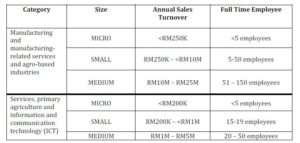
In Malaysia, a microenterprise is an SME with a number of full time worker is less than five or having a sales turnover of less than RM250,000.00, approximately USD80,000.00 (Saleh and Ndubisi, 2006). 434,939 or 78.67% of business establishments in Malaysia are derived from microenterprises and the statistics are shown in Table 2.
Table 2: No of Establishments by Size
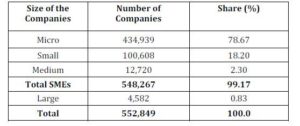
Microenterprises are unique when compared to larger organizations. They are very small owner-operated businesses with a small startup capital, technology and human resources (Charles and Florin, 2006). They typically serve as a self-employment option rather than working with others option (Cook and Belliveau, 2004).
In addition, they have the following organizational behavior characteristics: i) centralized decision making — most of all the decisions are made by the owner; ii) can run smoothly without long-term planning and standard practices; and iii) there is ‘greater dependence on external expertise and services for information system (IS) operations’ (Premkumar, 2003). However, the role of microenterprises in the economic growth is unquestionable.
They contribute to a stable and sustainable social and economic community environment and are important in building and maintaining the sustainability of the social, cultural, environment and economic development of communities (Samujh, 2011).
Microenterprises also create jobs, raise the standards of living for families and remove the need to rely on the environment for survival (World Vision, 1998). In most countries, microenterprises are predicted to cover between 95 per cent and 98 per cent of the local business entities. Given their importance to the economy, the developments of microenterprises have been made as a national priority (Eriksson et al., 2006; Economic and Social Commission for Western Asia, 2003). In Malaysia, microenterprises are destined to play a significant role in building the nation’s economy under the Malaysian New Economic Model (NSDC, 2010).
The Batik Microenterprise
Batik is a decorative cultural artifact produced by artistic work inspired by the batik artist’s natural surroundings. The charms of batik lie in its power of storytelling through hand-painted or block-printed motifs on textiles.
Batik textile has evolved from the task inherited by generations of batik maker families to team effort within an organization to produce batik textile for a more diversified consumer communities. However, it is still guided by a set of directives and intuitions reflecting a confluence of design and heritage knowledge confined to specific community culture and aesthetic constraints, resulting in the preservation of the designer’s and regional identity (Nordin et al., 2009).
Batik making has evolved into a socio-economic uplift within indigenous communities who operate the batik making business as a cottage industry and the Malaysian batik industry is currently dominated by batik producers who operate their business as indigenous microenterprises (Md Noor and Nordin, 2012).
Most of the indigenous batik microenterprises operate their business in the eastern part of the Malaysian peninsula, where there is less exposure to the global market. The importance of batik production in Malaysia does not only lie on its economic value as a means of livelihood amongst the indigenous community, but also on its cultural heritage value as batik is a national cultural identity. The Malaysian batik industry has been revived by the government intervention in support of the industry where financial and marketing assistance is given to microenterprises to help in their trade. However, the batik making tasks and the management of batik microenterprises are currently not supported by the use of IT.
Most of the Malaysian batik makers use traditional methods such as hand drawing or block printer to produce batik. They believe that the use of modern method will make batik lose its originality and quality (The Star, July 2009). The Malaysia batik industry is not only plagued with the threat of batik cultural erosion due to the lack of cultural knowledge and mimetic style related to the batik maker’s competency dimension, the industry also faces the problem of business sustainability (Md Noor and Nordin, 2012). The use of the traditional method needs lengthy process resulting in the inability to meet market demands. The distribution of batik from the microenterprises, as the producer to the customers can take several forms, as illustrated in Figure 1.

Fig 1. Batik Distribution from Producer to Buyer
Due to the limited capacity and insufficient fund, most of the batik microenterprises sell their product through a larger batik producer or middleman. This scenario did not offer batik microenterprises the chance to explore their market outside the market niche of the batik middleman, and thus deprives them of the opportunity to explore their potential new markets.
Although batik microenterprises have a large contribution to the Malaysian social and economic development, most of the business activities still abide by the manual processes. Thus, it raises questions on why there is a poor IT adoption among batik microenterprises. The common reasons given for non-adoption of IT are inadequate IT knowledge and skills and the lack of funds to invest in IT.
SMEs IT Adoption
The adoption and diffusion of IT throughout a productive system assumes a core position in the new economy and has spurred numerous IT adoption research conducted from different approaches. IT adoption amongst SMEs has been a major focus in the literature of IT management. IT adoption is discussed in the literature ranges from using IT in business operations to the use of e-commerce. Research on SMEs IT adoption attempt to determine whether IT adopted throughout the production process can produce positive outcomes related to operational efficiencies, increased revenues and better market positioning.
There is no specific method to categorise the barriers of IT adoption. Walcott, et al (2008) attempted to group the barriers and challenges into capabilities, resources, access, attitude, context and operations. Since there are distinctive barriers to IT adoption, the study approaches of Tornatzky and Fleischer (1990) in the challenges categorization, namely organization, technology and environment, is commonly followed. Thus, barriers and challenges related to human are considered to be related to organization. Table 3 illustrates the barriers and challenges of ICT adoption from previous literature.
Table 3: Barriers and Challenges of IT Adoption
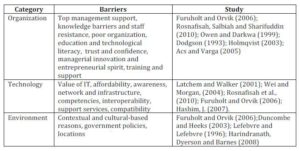
Studies have shown that while IT is recognized as a powerful tool for socio-economic development, the rate of SMEs IT adoption is slow (MacGregor and Vrazalic, 2005). The extensive review on SMEs IT adoption research undertaken by Ghobakhloo, et al (2011) has shown that factors that influence IT adoption can be both internal and external factors. Amongst the internal factors cited are lack of top management support, insufficiency of financial resources, slow acceptance of IT amongst SMEs internal users due to IT resource poverty, the lack of internal IT knowledge and expertise, organizational characteristics and characteristics of IT applications itself, referring to the high cost IT infrastructure and tools and the concern for IT security. These findings concur with the IT adoption factors of the Qureshi Model of IT for Development (Morales and Qureshi, 2010) which outline three important components: access to information and expertise, competitiveness and access to markets and administrative efficiencies.
Various studies have acknowledged that the larger firms are very fast adopters compared to smaller firms who are very slow in adopting any technology including IT (Burke 2005; Charles and Florin, 2006) and small enterprises do not take advantage of IT solution compared to large firms (Arendt, 2008). Small enterprises face numerous barriers and challenges in adopting IT. Limited availability of resources i.e. time, money and expertise are some of the constraints for small firms to adopt IT (Wymer and Regan, 2005). Harindranath et al. (2008) in their survey of 400 SMEs in UK found that there is a failure to recognise IT strategic potential and overwhelming ignorance of the government policy initiatives to support SMEs.
However, the attitudes of the respondents towards IT are quite good. The survey on about 1,429 SMEs in Bangladesh showed that their IT adoption is still in the very early stage. From the past literatures, Dewan and Nazmin (2008) identified the obstacles to adopt IT tools by SMEs in Bangladesh. The obstacles cited include: unsuitability for business, lack of availability of IT skilled personnel, cost of developing and maintaining IT tools, lack of network infrastructure issues and building security and trust.
Studies on IT adoption amongst Malaysian SMEs reveal similar results. One study conducted by Hashim (2007) acknowledged that the IT skills of SME owners in Malaysia are below than average. Due to this reason, SMEs owners in the study express their difficulty to adopt IT.
Even though the Malaysian government has tried very hard to encourage IT adoption among SMEs, the effort seems to be unsuccessful without IT awareness and IT skill improvement. In the survey conducted by Tan et al (2009), the factor and adoption patterns of Internet-based IT among SMEs in the southern region of Malaysia found that the usage of Internet-based IT application is still weak. Malaysian SMEs are only using Internet-based IT for e-mailing and web surfing purposes.
The relationship between profit and IT adoption in SMEs was shown in earlier work of Locke (2004), whose studies show a positive correlation between IT adoption and SME profitability. However, a more pertinent point was raised in the work of Stockdale and Standing (2006), who emphasize that SMEs need more personalised help, directed through local area initiatives, to encourage them to be more active in e-commerce.
Training vs. Therapy
Technology is useless without appropriate trainings to its potential users. Chan (2010) emphasizes the purpose of training is to teach people something that they need to know or be able to do for a specific objective. Prior studies have found the lack of IT skills and inadequate IT trainings are two of the common barriers in IT adoption among SMEs. (Arendt, 2008; Ghobakhloo et al, 2011; Wolcott, et al, 2007). Therefore, adequate strategies in facilitating training programs to SMEs should be carefully planned and applied for enhancing their business performances.
However, the ways of how the training must be conducted also need to be taken into consideration (Corbitt and Al-Qirim, 2004). Hashim (2010) suggests that the training agencies for SMEs must understand the constraints faced by them to ensure the training effectiveness. Hence, due to many challenges and barriers in the process of adopting IT for microenterprises, trainings in the model of “IT therapy” instead of “IT training” fits better to the context. Adopted from the medical procedure, IT therapy is the treatment for microenterprises that enable them to reduce most of the problems associated with their refusal on using IT.
The IT Therapy as an IT Adoption Method
The IT therapy was first introduced by Wolcott et al (2007) as a method that assists IT adoption among the small business communities. In their initial work, Wolcott et al (2007) conducted an action research on a group of participants from a heterogeneous set of microenterprises. The primary objective was to investigate the effects of IT interventions in microenterprise development, while assisting the microenterprise owners to solve their immediate IT needs. In this work, Wolcott et al (2007) coined the term IT Therapy that refers to the set of individualized IT solutions provided to the participants for performing their business tasks.
The tasks involved several stages of processes that include the provisioning of solutions for overcoming problems using IT. This action research was followed by a series of case studies involving IT Therapy to investigate the appropriate technology and training intervention for IT adoption in microenterprises by highlighting the capabilities identified.
Situational analysis through interviews, observations and engaging in their business activities were conducted. An important finding that is highlighted is that the essential factor for a successful adoption of IT is the understanding of the background of the microenterprises. Such understanding helps to recognize microenterprise attitude, reasons for IT resistance, readiness, awareness and IT capability.
The IT therapy introduced is in the form of IT intervention processes. The work of these researchers asserts that successful adoption of IT amongst microenterprises requires a good intervention technique. Due to the operation and size of microenterprises, the approach to the IT therapy needs to adhere to an individual microenterprise IT adoption behavior. Wolcott et al (2007) stress the importance of applying individualized technology-related assistance, with an emphasis on relationship-building, customized training, context sensitivity and solutions that target strongly perceived needs of the businesses studied. Table 4 summarizes the key aspects of the studies on IT therapy in a chronological order.
Table 4: Summary of IT Therapy Studies
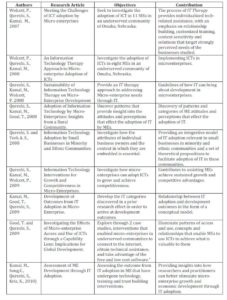
To further strengthen IT therapy as an IT adoption method, a refinement of its description is needed. Therefore, this research work attempts to model IT therapy based on conventional models of therapy used within the clinical procedure. A review of the various clinical therapy methods is discussed in the following sub-section before being considered as a candidate for modeling IT therapy.
Research Methodology
Preliminary Study
A preliminary study was undertaken to identify why batik microenterprises refuse to adopt IT. Interviews with a few Malaysian batik microenterprise owners were made to gauge the primary challenges faced by them. The study was done in June 2011 to better comprehend the nature of the business and the problems of batik textile microenterprise.
Two sets of interviews were conducted. The first interview was with ten batik micro-entrepreneurs and the second interview was with two representatives from Malaysian Handicraft Development Corporation. This study revealed that the lack of IT knowledge and lack of knowledge on how to use IT in their business operations are the common problems that lead to non-adoption of IT. The reasons given were in line with the reasons for non-adoption of IT in the research reported in the literature.
To overcome this problem, a special IT adoption method needs to be developed to educate and encourage batik microenterprises on the importance and the use of IT in sustaining their business. The following section discusses the approach of IT therapy as IT adoption method.
The Clinical Therapy
Therapy is synonymous with the clinical procedure. To achieve the objective of this study, a case study on the clinical therapy was carried out in November 2011 to gauge the use of the clinical method of the therapy. The outcome of this study is later being mapped into the new IT therapy conceptual model. To this end, documentation and face to face interviews were undertaken, as described below.
Documentation
Due to indistinctness on actual therapy process, the comparison of the clinical therapy documentation methods/styles has been made to identify the processes involved in conducting therapy. An analysis of thirteen documentation methods in clinical therapy (as in Table 5) was made by referring to a variety of nursing documentations and books.
Table 5 : Clinical Therapy Documentation Methods
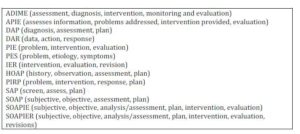
A comparison between the methods shown in Table 5 reveals that there is a close similarity between the methods. Some of the methods eliminate certain steps or combine one step with another. SOAP is considered one of the methods that is commonly used by the nurse or medical doctor because it is easy to learn and utilize. This clinical method became popular in the 1970s and it was taught in most clinical education programs (Shamus and Stern, 2004; Dziegielewski, 2004). A modified version of SOAP, resulted in SOAPIE and later on SOAPIER.
Face to Face Interview
Two field visits to a case study “sites” were made following the approach recommended by Yin (2003). The case study sites are a speech therapy clinic and physiotherapy centre in Shah Alam, the city where the researchers are residing. During the visit, observation on the site to take note of the facilities used in the therapy and personal interviews with two therapists on each site was made. The interview was on the actual therapy process practiced and the facilitation of the therapy. In addition, a copy of the documentation on the therapy procedure and documentation methods was made for further analysis.
Analysis and Findings
From the interview, it was found that the centre has developed their standard documentation procedures based on the facilities provided. Although there are standard documentations, the therapists do not work rigidly with the documentation method. It is also found that despite knowing the therapy process and procedures, the therapists from the older generation are not familiar with the name of the therapy methods named by the researcher. However, the therapists of the younger generation are familiar with the name of the therapy methods that the researcher mentioned. Based on the interview and observation, it was found that SOAP, SOAPIE and SOAPIER are the methods that are quite identical with their implementation. Based on these findings, a decision was made to use SOAPIE to model the IT therapy process due to its practicality based on time duration. The “R” (revisions or review plan) in SOAPIER that was described in Table 5 is not included due to constraints in managing the activity within a limited time.
Conceptual Modeling of the IT Therapy
The modelling of IT therapy consists of two main areas: the components and the process. Three main components were identified similar to what exists in the clinical therapy. These components are the patient which is the microenterprise, the therapist which is the IT trainer and the therapy method. The model can be represented in (i)
IT Therapy=f(P,T,M) (i)
P — patient (microenterprise); T — therapist (trainer); M — therapy method
The patient in the IT therapy is the owner of a microenterprise (micro-entrepreneur) because he is the most important entity that knows the company’s strength and weaknesses besides being the main person operating the business and is in the position of deciding the business directions. Accredited trainers are the therapists in IT therapy sessions. They will guide and monitor the micro-entrepreneur during the therapy period following the therapy method prescribed. The IT training method follows the process that is mapped from the clinical therapy and is illustrated in Figure 2
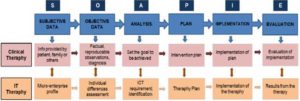
.
Fig 2. Mapping Clinical Therapy vs. IT Therapy via SOAPIE
The mapping outlines six important processes. The first process is the Subjective data profiling which the microenterprise is profiling. This will involve the process of collecting the microenterprise information, including the micro-entrepreneur’s demographic data, the company’s history, the business operations and the IT skills and knowledge.
This information is important to gauge the micro-entrepreneur feelings towards the microenterprise’s problem. As microenterprises are unique in their intention or decision to adopt or reject IT as an individual decision, the next process is to record the Objective data on individual (microenterprise) differences and their perceptions towards IT that may affect the IT adoption decisions. The Analysis/Assessment is the process to analyse the microenterprise’s IT requirements. Based on the preliminary study, it is found that some of the micro-entrepreneurs are not aware of the IT benefits for their business.
The objective of this process is to identify the area that needs IT to assist their business operations by highlighting the benefits of IT for their business. The information gathered will give some input for the IT tools development in the later process. The next process is the Plan, where the trainer will look into how the training objectives will be carried out.
The whole therapy programmes will be planned, including the development of program schedule, modules, applications, assessment tools etc. The Implementation process will explain exactly how, when and who will implement the therapy. The last process is the Evaluation that will be carried out and is designated to represent the therapy result.
The Batik Microenterprise as the Context
As previously stated, Stockdale and Standing (2006) have emphasized that SMEs need more personalised help, directed through local area initiatives, to encourage them to be more receptive in IT adoption. The work of Qureshi on IT therapy as illustrated in the earlier sections also laid emphasis on personalized attention towards propagating IT adoption amongst IT non-adopters. The search for a viable IT adoption model requires a good context of study. Unlike the work of Qureshi where heterogeneous microenterprises were used in their study, the refinement of the IT therapy requires a homogenous microenterprise set-up.
In the context of Malaysia, the batik microenterprise offers a good context to study IT adoption method amongst non-adopters of IT. The characteristics of batik microenterprises include the size of the enterprise, the workers and the working relationship within the microenterprise and the fear for the threat of sustaining the batik making business. The work of Nordin (2011) that outlines the fear of discontinuity of traditional aesthetic attributes amongst the batik making enterprise community, poses the challenge of IT adoption in the batik making business.
The concern of the batik microenterprises includes the fear of their work being copied by ruthless businessmen and the conception that IT will promote easy access to their work from competitors overlooks the potential of using IT in the business operation, such as the administrative and marketing operations. The preliminary investigation mentioned in the introduction of this paper conforms to the findings of Nordin (2011) and this further persuades the researcher to use the batik microenterprises as the context of the IT therapy.
Conclusion
This paper has highlighted the issue of seeking a good method of promoting the adoption of IT amongst non-IT adopters. IT therapy that was used in past action researches investigating the barriers to IT adoption offer a potential adoption method that has not been refined. This research attempted to develop a conceptual model of IT therapy by mapping the structure and process of IT therapy from the clinical therapy. Future work will proceed to the validation of the IT therapy conceptual model through experimental work using batik micro-entrepreneurs as the participants. The outcome of this research can offer a better solution towards improving the business of microenterprise by encouraging them to use efficient operational procedures supported by IT tools.
References
Acs, Z. & Varga, A. (2005). “Entrepreneurship, Agglomeration and Technological Change,” Small Business Economics, 24(3), 323-334.
Publisher – Google Scholar
Alam, S. S. & Noor, M. K. M. (2009). “ICT Adoption in Small and Medium Enterprises: An Empirical Evidence of Service Sectors in Malaysia,” International Journal of Business and Management, 4(2), 112-125.
Publisher – Google Scholar
Arendt, L. (2008). “Barriers to ICT Adoption in SMEs: How to Bridge the Digital Divide,” Journal of Systems and Information Technology, 10(2), 93 — 108.
Publisher – Google Scholar
Brian, J., Corbitt & Nabeel, A. Y. Al-Qirim. (2004). ‘E-Business, E-Government & Small and Medium Size Enterprise : Opportunities & Challenges,’ IGI Publishing Hershey, PA,USA.
Burhanuddin, M. A., Arif, F., Azizah , V. & Prabuwono, A. S. (2009). “Barriers and Challenges for Technology Transfer in Malaysian Small and Medium Industries,” International Conference on Information Management and Engineering (ICIM”09), 258-261.
Publisher – Google Scholar
Burke, K. (2005). “The Impact of Firm Size on Internet Use in Small Businesses,” Journal of Electronic Markets, 15(2), 79-93.
Publisher – Google Scholar – British Library Direct
Chan, J. F. (2010). ‘Training Fundamental: Pfeifter Essential Guides to Training Basics,’ John Willey & Sons, Inc., San Francisco.
Cook, R. G. & Belliveau, P. (2004). “The Influence of Human Capital Attributes in Microenterprise Training,” Journal of Small Business and Enterprise Development, 11(4), 467 — 473.
Publisher – Google Scholar – British Library Direct
Davis, C. H. & Vladica, F. (2006). “Use of Internet Technologies and e-Business Solutions: A Structural Model of Sources of Business Value among Canadian Micro-Enterprises,” Proceedings of the 39th Hawaii International Conference on Systems Science (HICSS), ISBN: 0-7695-2507-5, 4-7 January 2006, Kauai, Hawaii, Track 8.
Publisher – Google Scholar – British Library Direct
Dewan, A. M. & Nazmin, S. A. (2008). “The Opportunities and Barriers of Using ICT by Small and Medium Enterprises in Bangladesh: Case of SMEs in BSCIC Industrial Estates,“ Proceedings of Computer and Communication Engineering, 2008 (ICCCE), ISBN: 978-1-4244-1691-2, 13-15 May 2008, Kuala Lumpur, Malaysia, 656 — 661.
Publisher – Google Scholar
Dodgson, M. (1993). “Organizational Learning: A Review of Some Literatures,” Organization Studies, 14(3), 375-94.
Publisher – Google Scholar – British Library Direct
Duncombe, R. & Heeks, R. (2003). “An Information Systems Perspective on Ethical Trade and Self-Regulation,”Information Technology for Development, 10(2), 123-139.
Publisher – Google Scholar – British Library Direct
Dziegielewski , S. F. (2004). The Changing Face of Health Care Social Work: Professional Practice in Managed Behavioral Health Care, Second Edition, Springer Publishing Company, Inc, New York.
Publisher – Google Scholar
Eriksson, L. T. & Hultman, J. (2005). “One Digital Leap or a Step-by-step Approach? — An Empirical Study of E-commerce Development Amongst Swedish SMEs,” International Journal of Electronic Business, 3(5), 447-460.
Publisher – Google Scholar – British Library Direct
Flores Morales, L. & Qureshi, S. (2010). “Investigating the Effects of IT Adoption between Micro-Enterprises from an Ethnic Community in the United States,” Proceedings of SIG GlobDev Third Annual Workshop,ISBN: 978-0-9826068-2-7, 12 December 2010, Saint Louis, USA,
Publisher – Google Scholar
Furuholt, B. & Ørvik, T. U. (2006). “Implementation of Information Technology in Africa: Understanding and Explaining the Results of Ten Years of Implementation Effort in a Tanzanian Organization,” Information Technology for Development, 12(1), 45-62.
Publisher – Google Scholar – British Library Direct
Ghobakhloo, M., Sabouri , M. S., Hong, T. S. & Zulkifli, N. (2011). “Information Technology Adoption in Small and Medium-sized Enterprises; An Appraisal of Two Decades Literature,” Interdisciplinary Journal of Research in Business, 1(7), 53-80.
Publisher – Google Scholar
Go modern to Boost Batik. (2009, July 2009). The Star, p. 1
Good, T. & Qureshi, S. (2009). “Investigating the Effects of Micro-enterprise Access and Use of ICTs through a Capability Lens: Implications for Global Development,” Proceedings of Second Annual SIG GlobDev Workshop, Phoenix, USA, 2009.
Publisher – Google Scholar
Harindranath, G., Dyerson, R. & Barnes, D. (2008). “ICT in Small Firms: Factors Affecting the Adoption and Use of ICT in Southeast England SMEs,” Proceedings of the 2008 European Conference on Information Systems (ECIS), Galway, Ireland, ECIS.
Publisher – Google Scholar
Hashim, J. (2007). ‘Information and Commuication Technology (ICT) Adoption among SME Owner in Malaysia,’International Journal of Business and Information, 2(2), 221 — 240.
Helen Samujh, R. (2011). “Micro-businesses Need Support: Survival Precedes Sustainability,” Corporate Governance, 11(1), 15 — 28.
Publisher – Google Scholar
Holmqvist, M. (2003). “A Dynamic Model of Intra- and Interorganizational Learning,” Organization Studies, 24(1), 95-123.
Publisher – Google Scholar – British Library Direct
Hussin, H. & Noor, R. M. (2005). “Innovating Business Through E-Commerce: Exploring The Willingness of Malaysian SMEs,” Proceedings of the Second International Conference on Innovation in IT.
Publisher – Google Scholar
Kamal, M., Changsoo Song, Qureshi, S. & Kriz, K. (2010). “Assessment of Micro-Enterprise Development through IT Adoption,” Proceedings of the 43rd Annual Hawaii International Conference on System Sciences (HICSS ),1-10.
Publisher – Google Scholar
Latchem, C. & Walker, D. (2001). ‘Telecentres: Case Studies and Key Issues,’ The Commonwealth of Learning, Vancouver.
Lefebvre, L. & Lefebvre, L. A. (1996). Information and Telecommunication Technologies: The Impact of Their Adoption on Small and Medium-sized Enterprises, [online], [Retrieved November 3, 2009],
http://web.idrc.ca/en/ev-9303-201-1-DO_TOPIC.html
Publisher
Locke, S. (2004). “ICT Adoption and SME Growth in New Zealand,” The Journal of American Academy of Business, Cambridge, 93-102.
Publisher – Google Scholar
MacGregor, R. C. & Vrazalic, L. (2007). E-commerce in Regional Small to Medium Enterprises, IGI Publishing, Hershey.
Publisher – Google Scholar
Md Noor, N. L. & Nordin, A. (2012). “Requirements Elicitation for the Technology Conception of a Community Information System for the Indigenous Microenterprise: A Contextual Multi-Analysis Approach on Business and Community Requirements of Batik Making,” The Electronic Journal on Information Systems Evaluation, 15(1), 102 -115.
Publisher – Google Scholar
National SME Development Council (2010). SME Annual Report 2009/10, Bank Negara Malaysia’ Kuala Lumpur.
Nordin, A. (2011). ‘Conceptual Framework for Culture-Based Knowledge Creation Support System: Case of the Malaysian Batik Community,’ PhD Thesis, Universiti Teknologi MARA, Shah Alam, Malaysia.
Nordin, A., Md. Noor, N. L. & Zainuddin, A. (2009). “Batik KR Semantic Network: Visualizations of Creative Process and Design Knowledge for the Malaysian Batik Designers’ Community,” Human Interface and the Management of Information. Information and Interaction. Lecture Notes in Computer Science, 5618/2009, 334-341.
Publisher – Google Scholar
Owen, W. & Darkwa, O. (1999). ‘Role of Multipurpose Community Telecentres in Accelerating National Development in Ghana,’ First Monday, 5(1), 1-23.
Premkumar, G. (2003). “A Meta-Analysis of Research on Information Technology Implementation in Small Business,”Journal of Organizational Computing and Electronic Commerce, 13(2), 91-121.
Publisher – Google Scholar – British Library Direct
Qureshi, S., Kamal, M. & Good, T. (2008). “Adoption of Information Technology by Micro-Enterprises: Insights from a Rural Community,” Proceedings of AMCIS 2008. Paper 335.
Publisher – Google Scholar
Qureshi, S., Kamal, M. & Wolcott, P. (2008). “Sustainability of Information Technology Therapy on Micro-enterprise Development,” Proceedings of the 41st Annual Hawaii International Conference on System Sciences (HICSS ).
Publisher – Google Scholar
Qureshi, S., Kamal, M. & Wolcott, P. (2009). “Information Technology Interventions for Growth and Competitiveness in Micro-Enterprises,” International Journal of E-Business Research, 5(1), 117-140.
Publisher – Google Scholar
Qureshi, S. & York, S. A. S. (2008). “Information Technology Adoption by Small Businesses in Minority and Ethnic Communities,” Proceedings of the 41st Annual Hawaii International Conference on System Sciences.
Publisher – Google Scholar
Robert K. Yin. (2003). ‘Case Study Research: Design and Method,’ 3rd ed, Sage Publications.
Rosnafisah, S., SitiSalbiah, M. S. & Sharifuddin, A. M. (2010). Factors Affecting The E-business Adoption among The Home-based Businesses (HBBs) in Malaysia,’ World Academy of Science, Engineering and Technology, 6, 1250-1254.
Saleh, A. S. & Ndubisi, N. O. (2006). “An Evaluation of SME Development in Malaysia,” International Review of Business Research Papers, 2(1), 1-14.
Publisher – Google Scholar
Shamus, S. S. (2004). “Effective Documentation for Physical Therapy Professionals,” McGraw Hill Co. Inc. USA.
Publisher – Google Scholar
Stockdale, R. & Standing, C. (2006). “A Classification Model to Support SME E-Commerce Adoption Initiatives,” Journal of Small Business and Enterprise Development, 13(3), 381 — 394.
Publisher – Google Scholar – British Library Direct
Tan, K., Eze, U. C., Ong, P. T. (2009). ‘Dissertation,’ Multimedia University, Malaysia.
Tornatzky, L. G. &Fleischer, M. (1990). ‘The Process of Technological Innovation,’ Lexington Book.
Wei, Y. S. & Morgan, N. A. (2004). ”Supportiveness of Organizational Climate, Market Orientation and New Product Performance in Chinese Firms,” Journal of Product Innovation Management, 21(6), 375-88.
Publisher – Google Scholar – British Library Direct
Wolcott, P., Kalam, M. & Qureshi, S. (2008). “Meeting The Challenges of ICT Adoption by Micro-Enterprises,” Journal of Enterprise Information Management, 21(6), 616-632.
Publisher – Google Scholar
Wolcott, P., Qureshi, S. & Kamal, M. (2007). “An Information Technology Therapy Approach to Micro-Enterprise Adoption of ICTs,” Proceedings of 13th Americas Conference on Information Systems (AMCIS), 9-12 August 2007, Keystone, Colorado, USA, 73
Publisher – Google Scholar
Wymer, S. A. & Regan, E. A. (2005). “Factors Influencing E-Commerce Adoption and Use by Small and Medium Businesses,” Electronic Markets, 15(4), 438-453.
Publisher – Google Scholar – British Library Direct
Za’faran Hassan. (2007). Entrepreneurship Development for Competitive Small and Medium Enterprises: Development Strategy of Malaysia in Entrepreneurship Development for Competitive Small and Medium Enterprises, Tokyo, Japan:Asian Productivity Organization.
Publisher









